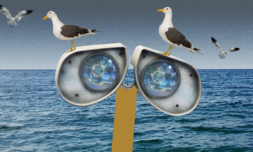With the aim of creating more natural carbon banks, Phykos has pioneered an autonomous device capable of growing seaweed in shallow water and dragging it out to the open ocean.
As you’ve probably heard by now, seaweed is good for a whole lot more than livening up your weekly stir fry.
One of nature’s most remarkable allies when it comes to sustainability, seaweed is thought to sequester nearly 200 million tons of carbon dioxide each year.
Absorbing harmful emissions directly from our atmosphere, this marine algae also helps to rehabilitate its local environment by lowering surrounding acidity levels.
Scientists have even suggested that introducing seaweed into the diet of domestic cows would likely slash methane pollution from the agriculture industry.
Given all of these invaluable benefits (and the fact we’re on the cusp of a climate crisis), it’s a huge worry that such a valuable natural resource continues to be scorched by rising temperatures.
With 95% of seaweed forests destroyed over the past 80 years, entire coastal systems are still at threat of expiring – which in itself would release rapid bursts of carbon.
In the same way environmentalists are reliant on planting trees to save our forests in the short term, marine biologists are constantly looking for ways to reacclimate our oceans with seaweed.
One such project, pioneered by tech start-up Phykos, is currently providing real promise on that front.
Phykos’ AI seaweed vessels
Comprised of several former members of Google’s moonshot factory, X Development – which knows a thing or two about state-of-the-art climate engineering – Phykos aims to focus entirely on utilising our oceans for decarbonisation.
Recognising the immense potential to bring seaweed projects to a ‘meaningful scale’ for low costs, Phykos decided it would work on tech solutions to populate the high seas, in which such algae doesn’t usually grow.
With this fundamental mission in mind, the start-up built a device capable of growing seaweed in its prime conditions in shallow water, before autonomously ferrying it out to open sea where it will theoretically sink to the seabed.
Its flagship vessel (currently unnamed) is roughly the size of a one-seater boat and powered entirely by solar energy. A series of nets hangs below which act as a nursery for the chosen species of seaweed.
In the initial stages of the process, the vessel will spend its time in shallow water growing and tending to each line through an on-board ‘harvest clipper’ system. Nifty, eh?
Once the seaweed is all grown up, the vessel’s clever AI systems come into play. Heading out to the open ocean, the device will actively seek out cooler areas before dropping the seaweed for good.
It’s navigation is also said to account for shipping lanes whilst avoiding pre-designated animal hotspots. A single family of manatees would likely clear the lot.
Phykos claims to have most of the science down and its vessel sounds mighty impressive on paper, but when exactly can we expect to see the real thing?





















